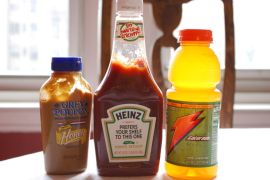World food prices hit record high: UN agency
February 3, 2011 1 Comment
AFP
February 3, 2011
World food prices reached their highest level ever recorded in January and are set to keep rising for months, the UN food agency said on Thursday, warning that the hardest-hit countries could face turmoil.
Rising food prices have been cited among the driving forces behind recent popular revolts in north Africa, including the uprising in Egypt and the toppling of Tunisia’s long-time president Zine El Abidine Ben Ali.
And in its latest survey, the Food and Agriculture Organisation said its index which monitors monthly price changes for a variety of staples averaged 231 points in January — the highest level since records began in 1990.
“The new figures clearly show that the upward pressure on world food prices is not abating. These high prices are likely to persist in the months to come,” FAO economist and grains expert Abdolreza Abbassian said in a statement.
The Index rose by 3.4 percent from December — with big increases in particular for dairy, cereal and oil prices. The rises were most significant in China, India, Indonesia and Russia, data from FAO’s monthly report showed.
“There are a lot of factors that could spark turmoil in countries and food is one of them,” Abbassian said, pointing out however that several countries have become better at managing prices after a series of riots in 2007 and 2008.
“They have learnt from previous episodes,” he said, adding however: “These are obviously not very easy times. There is now no hope that prices will return to anything we can consider normal, at least until the summer.”
The data from the Rome-based FAO showed that prices for dairy products rose by 6.2 percent from December, oils and fats gained 5.6 percent, while cereals went up by 3.0 percent because of lower global supply of wheat and maize.
“The increase in prices follows stronger export demand during the last month and concerns about tightening supplies of high quality wheat. The market was also supported by higher oil prices and a weaker US dollar,” FAO said.
Meat prices remained broadly stable due to a fall in prices in Europe caused by last month’s scare over dioxin poisoning in eggs and pork in Germany, compensated by a slight increase in export prices from Brazil and the US.
“High food prices are of major concern especially for low-income food deficit countries that may face problems in financing food imports and for poor households which spend a large share of their income on food,” Abbassian said.
Global aid agency Oxfam said: “Millions of people’s lives are at risk.”
“Poor people in developing countries spend between 50 and 80 percent of their income on food, making higher prices, as well as unpredictable prices, a serious threat to their ability to eat,” Oxfam said in a statement.
Oxfam blamed the price rises on reduced production due to bad weather, increased oil prices making fertilizer and transport more expensive, increased demand for biofuels, export restrictions and financial speculation.
It called on governments to implement social protection programmes for the people hardest hit by the price rises and to help control prices “by increasing support and investments in small scale agriculture.”
The FAO data showed the Food Price Index hit 200 points over the whole of 2008 at the height of the 2007/2008 food crisis. It breached that level for the first time in October 2010 with 205 points.
In Africa, Somalia has been particularly hard hit by a rise in prices for red sorghum and maize due to a poor 2010 crop, while Uganda has seen a rise in the price of maize because of strong demand from neighbouring countries.
Meanwhile ongoing unrest in Ivory Coast had helped push up prices in West Africa as a whole because of its status as a key transport hub, it said.
But the most dramatic rises were seen in Asia and in particular in Bangladesh, China, India, Indonesia and China, it added.

